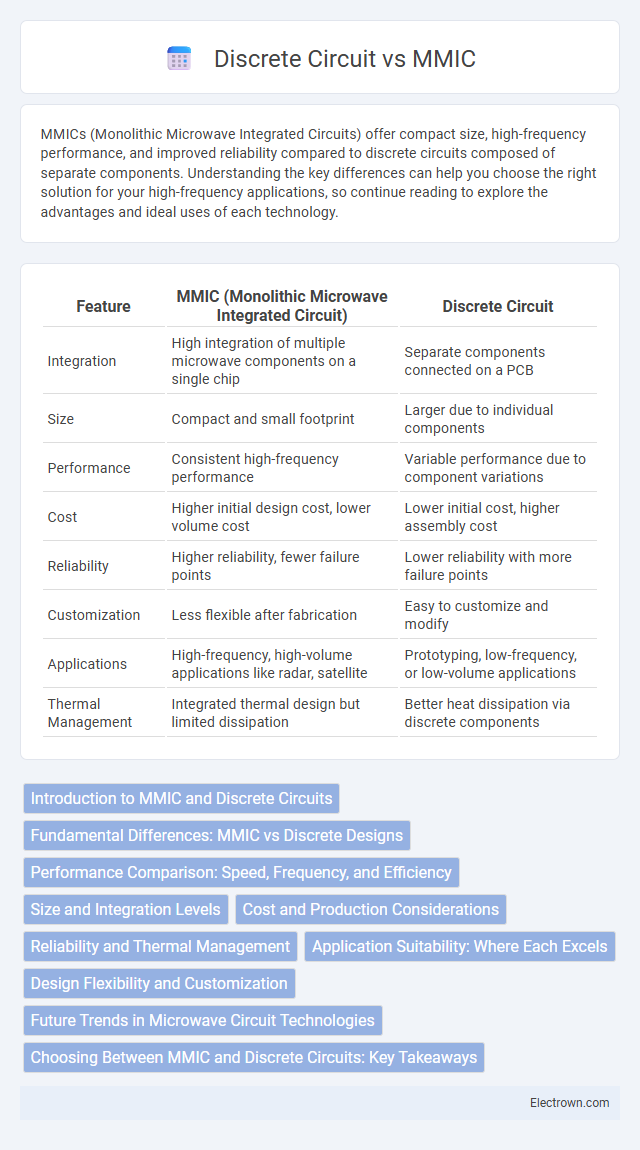MMICs (Monolithic Microwave Integrated Circuits) offer compact size, high-frequency performance, and improved reliability compared to discrete circuits composed of separate components. Understanding the key differences can help you choose the right solution for your high-frequency applications, so continue reading to explore the advantages and ideal uses of each technology.
Table of Comparison
| Feature | MMIC (Monolithic Microwave Integrated Circuit) | Discrete Circuit |
|---|---|---|
| Integration | High integration of multiple microwave components on a single chip | Separate components connected on a PCB |
| Size | Compact and small footprint | Larger due to individual components |
| Performance | Consistent high-frequency performance | Variable performance due to component variations |
| Cost | Higher initial design cost, lower volume cost | Lower initial cost, higher assembly cost |
| Reliability | Higher reliability, fewer failure points | Lower reliability with more failure points |
| Customization | Less flexible after fabrication | Easy to customize and modify |
| Applications | High-frequency, high-volume applications like radar, satellite | Prototyping, low-frequency, or low-volume applications |
| Thermal Management | Integrated thermal design but limited dissipation | Better heat dissipation via discrete components |
Introduction to MMIC and Discrete Circuits
Monolithic Microwave Integrated Circuits (MMICs) integrate multiple microwave components onto a single semiconductor substrate, offering compact size and high-frequency performance ideal for modern communication systems. Discrete circuits consist of individual components such as transistors, resistors, and capacitors connected externally, providing flexibility and ease of customization for low-frequency or specialized applications. Your choice between MMIC and discrete circuits depends on factors like frequency requirements, size constraints, and production volume.
Fundamental Differences: MMIC vs Discrete Designs
MMICs (Monolithic Microwave Integrated Circuits) integrate multiple microwave components on a single semiconductor substrate, offering compact size, uniform performance, and high-frequency operation up to millimeter-wave frequencies. Discrete circuits use separate individual components like transistors, resistors, and capacitors assembled on a PCB, allowing flexible customization but often resulting in larger footprints and higher parasitic losses. Your choice depends on balancing miniaturization, frequency requirements, and manufacturing complexity for optimal microwave system performance.
Performance Comparison: Speed, Frequency, and Efficiency
Monolithic Microwave Integrated Circuits (MMICs) offer superior speed and operate efficiently at higher frequencies, often exceeding 40 GHz, compared to discrete circuits which typically perform optimally below 10 GHz. MMICs integrate multiple components on a single chip, reducing parasitic capacitance and inductance, resulting in lower signal loss and higher efficiency. Discrete circuits, while flexible and easier to modify, generally consume more power and exhibit slower response times due to longer interconnect paths and component variability.
Size and Integration Levels
MMICs (Monolithic Microwave Integrated Circuits) offer significantly smaller size and higher integration levels compared to discrete circuits, as they combine multiple microwave components onto a single semiconductor substrate. This compact integration reduces parasitic elements and improves performance consistency, making MMICs ideal for space-constrained and high-frequency applications. Your design benefits from enhanced reliability and reduced manufacturing complexity when choosing MMIC technology over traditional discrete circuit assemblies.
Cost and Production Considerations
MMICs (Monolithic Microwave Integrated Circuits) offer lower overall production costs for high-volume manufacturing due to their integration of multiple components on a single chip, reducing assembly time and material expenses. Discrete circuits often incur higher costs from individual component sourcing, manual assembly, and increased testing complexity, making them less economical for large-scale production. For your projects requiring consistent performance and cost-effective mass production, MMICs present a more efficient choice.
Reliability and Thermal Management
MMICs (Monolithic Microwave Integrated Circuits) offer superior reliability over discrete circuits due to their integrated fabrication process, reducing assembly imperfections and component mismatches. Thermal management in MMICs is enhanced by their compact design and efficient heat dissipation through substrate materials like GaAs or GaN, whereas discrete circuits often face challenges with uneven heat distribution and thermal stress at solder joints. The minimized parasitic effects in MMICs also contribute to stable thermal performance and long-term operational consistency.
Application Suitability: Where Each Excels
MMICs excel in high-frequency applications such as radar systems, satellite communications, and millimeter-wave transceivers due to their compact size, reliability, and consistent performance. Discrete circuits are more suitable for low-frequency, high-power, or customized analog applications where flexibility in component selection and modification is critical. The choice depends on specific requirements like frequency range, power levels, integration complexity, and cost considerations.
Design Flexibility and Customization
MMICs offer limited design flexibility due to their monolithic integration but deliver consistent performance and compact size ideal for mass production. Discrete circuits provide higher customization options, allowing you to tailor each component to specific requirements for optimized performance in unique applications. Your choice depends on whether precision and scalability or individualized circuit tuning are prioritized in the design process.
Future Trends in Microwave Circuit Technologies
Future trends in microwave circuit technologies emphasize the increasing adoption of MMICs (Monolithic Microwave Integrated Circuits) due to their superior integration, miniaturization, and performance at higher frequencies. Discrete circuits remain relevant for customized applications but face limitations in scalability and cost-effectiveness compared to MMIC-based solutions. Your choice of technology should consider advancements in MMIC fabrication techniques, such as GaN and SiGe processes, which promise enhanced power efficiency and frequency capabilities essential for 5G and beyond.
Choosing Between MMIC and Discrete Circuits: Key Takeaways
Choosing between MMIC (Monolithic Microwave Integrated Circuit) and discrete circuits depends on factors like performance, size, and cost. MMICs offer compact size, consistent performance, and lower parasitics, making them ideal for high-frequency applications, while discrete circuits provide greater flexibility and easier customization. Your decision should align with specific design requirements, frequency range, and integration needs for optimal results.
MMIC vs Discrete Circuit Infographic

 electrown.com
electrown.com